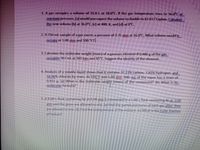
Chemistry
10th Edition
ISBN: 9781305957404
Author: Steven S. Zumdahl, Susan A. Zumdahl, Donald J. DeCoste
Publisher: Cengage Learning
expand_more
expand_more
format_list_bulleted
Concept explainers
Question
thumb_up100%

Transcribed Image Text:1. A gas occupies a volume of 31.0 L at 18.0°C. If the gas temperature rises to 36.0 C at
constant pressure, (a) would you expect the volume to double to 62.0 L? Explain. Calculate
the new volume (b) at 36.0°C, (c) at 400. K, and (d) at 0"C.
2. A 256 ml sample of a gas exerts a pressure of 2.75 atm at 16.0°C. What volume would it
OCcupy at 1.00 atm and 100.C?|
3. Calculate the molecular weight (mass) of a gaseous element if 0.480 g of the gas
Occupies 367 ml at 365 torr and 45°C. Suggest the identity of the element.
4. Analysis of a volatile liquid shows that it contains 37.23% carbon, 7.81% hydrogen, and
54.96% chlorine by mass. At 150.°C and 1.00 atm, 500. mL of the vapor has a mass of
0.922 g. (a) What is the molecular weight (mass) of the compound? (b) What is its
molecular formula?
5. A 4.00-L flask containing He at 6.00 atm is connected to a 2.00-L flask containing Na at 3.00
atm and the gases are allowed to mix. (a) Find the partial pressures of each gas after they
are allowed to mix. (b) Find the total pressure of the mixture. (c) What is the mole fraction
of helium?
Expert Solution
This question has been solved!
Explore an expertly crafted, step-by-step solution for a thorough understanding of key concepts.
This is a popular solution
Trending nowThis is a popular solution!
Step by stepSolved in 3 steps

Knowledge Booster
Learn more about
Need a deep-dive on the concept behind this application? Look no further. Learn more about this topic, chemistry and related others by exploring similar questions and additional content below.Similar questions
- Radon is a toxic gas that exists in minute quantities in most homes. If a sample of radon gas occupies a volume of 36.0L at 17.0°C, at what temperature, in °C, will it occupy a volume of 15.0L if the pressure remains constant? (Hint: Convert ° C to K) Your Answer:arrow_forwardFor many purposes we can treat methane (CH,) as an ideal gas at temperatures above Its bolling point of-161. °C. Suppose the temperature of a sample of methane gas is ralsed from -21.0 °C to 13.0 °C, and at the same time the pressure is changed. If the Initlal pressure was 2.8 atm and the volume Increased by 30.0%, what is the final pressure? Round your answer to the correct number of significant digits. atm x10arrow_forwardFor many purposes we can treat propane (C3H8) as an ideal gas at temperatures above its boiling point of -42. °C. Suppose the temperature of a sample of propane gas is lowered from 13.0 °C to -17.0 °C, and at the same time the pressure is changed. If the initial pressure was 3.3 atm and the volume increased by 30.0%, what is the final pressure? Round your answer to 2 significant digits. a atm ☐ x10 Xarrow_forward
- At 298 K, a 5.0-L flask contains 0.15 mol of O2 and 0.22 mol of N2. Calculate the partial pressure of N2 inside the container. (Note: the ideal gas constant is 0.0821 L•atm/mol•K)arrow_forward(a) A volume (25.0 L) of gas at 45 K is heated to 450 K. What volume (in L) does the gas now occupy? (b) A volume (50.0 mL) of gas at 400. °C is cooled to 50. °C. What volume (in mL) does the gas now occupy?arrow_forward1. Express R, the gas law constant in units of mL•kPa/mol•K by converting L and atm to mL and kPa, respectively. Show all your work and calculations.arrow_forward
- A sample of helium gas occupies a volume of 8.14 L at 57.0°C and 1.09 atm. If it is desired to increase the volume of the gas sample to 10.8 L, while decreasing its pressure to 0.730 atm, the temperature of the gas sample at the new volume and pressure must be (blank) °C.arrow_forwardIf a sample of Xenon gas occupies a volume of 31.0L at 17.0°C, at what temperature, in °C, will it occupy a volume of 7.0L if the pressure remains constant? (Hint: Convert ° to K)arrow_forward
arrow_back_ios
arrow_forward_ios
Recommended textbooks for you
 ChemistryChemistryISBN:9781305957404Author:Steven S. Zumdahl, Susan A. Zumdahl, Donald J. DeCostePublisher:Cengage Learning
ChemistryChemistryISBN:9781305957404Author:Steven S. Zumdahl, Susan A. Zumdahl, Donald J. DeCostePublisher:Cengage Learning ChemistryChemistryISBN:9781259911156Author:Raymond Chang Dr., Jason Overby ProfessorPublisher:McGraw-Hill Education
ChemistryChemistryISBN:9781259911156Author:Raymond Chang Dr., Jason Overby ProfessorPublisher:McGraw-Hill Education Principles of Instrumental AnalysisChemistryISBN:9781305577213Author:Douglas A. Skoog, F. James Holler, Stanley R. CrouchPublisher:Cengage Learning
Principles of Instrumental AnalysisChemistryISBN:9781305577213Author:Douglas A. Skoog, F. James Holler, Stanley R. CrouchPublisher:Cengage Learning Organic ChemistryChemistryISBN:9780078021558Author:Janice Gorzynski Smith Dr.Publisher:McGraw-Hill Education
Organic ChemistryChemistryISBN:9780078021558Author:Janice Gorzynski Smith Dr.Publisher:McGraw-Hill Education Chemistry: Principles and ReactionsChemistryISBN:9781305079373Author:William L. Masterton, Cecile N. HurleyPublisher:Cengage Learning
Chemistry: Principles and ReactionsChemistryISBN:9781305079373Author:William L. Masterton, Cecile N. HurleyPublisher:Cengage Learning Elementary Principles of Chemical Processes, Bind...ChemistryISBN:9781118431221Author:Richard M. Felder, Ronald W. Rousseau, Lisa G. BullardPublisher:WILEY
Elementary Principles of Chemical Processes, Bind...ChemistryISBN:9781118431221Author:Richard M. Felder, Ronald W. Rousseau, Lisa G. BullardPublisher:WILEY

Chemistry
Chemistry
ISBN:9781305957404
Author:Steven S. Zumdahl, Susan A. Zumdahl, Donald J. DeCoste
Publisher:Cengage Learning

Chemistry
Chemistry
ISBN:9781259911156
Author:Raymond Chang Dr., Jason Overby Professor
Publisher:McGraw-Hill Education

Principles of Instrumental Analysis
Chemistry
ISBN:9781305577213
Author:Douglas A. Skoog, F. James Holler, Stanley R. Crouch
Publisher:Cengage Learning

Organic Chemistry
Chemistry
ISBN:9780078021558
Author:Janice Gorzynski Smith Dr.
Publisher:McGraw-Hill Education

Chemistry: Principles and Reactions
Chemistry
ISBN:9781305079373
Author:William L. Masterton, Cecile N. Hurley
Publisher:Cengage Learning

Elementary Principles of Chemical Processes, Bind...
Chemistry
ISBN:9781118431221
Author:Richard M. Felder, Ronald W. Rousseau, Lisa G. Bullard
Publisher:WILEY